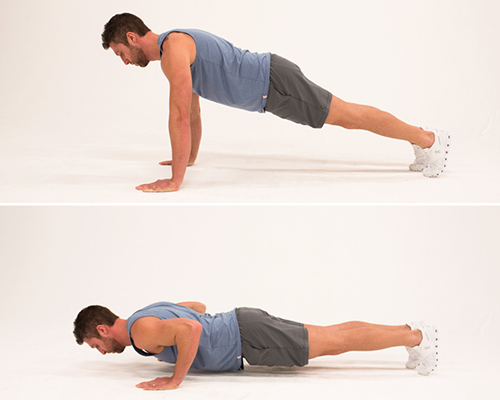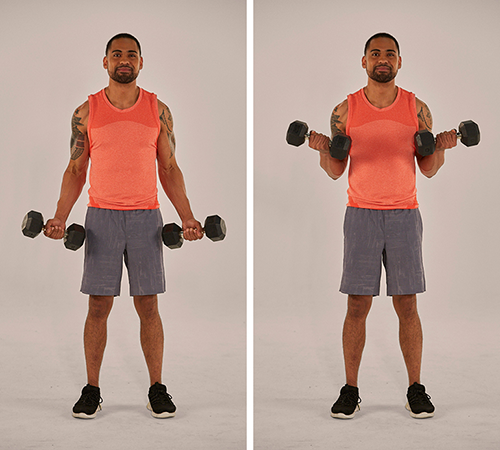
Maximize Strength and Hypertrophy With Increased Time Under Tension
By Jenessa Connor
When it comes to weight training, consistency is crucial — but monotony will sabotage your results. Stick to the same lifts, weights, and rep schemes, and you're bound to hit a plateau. One simple way to shake up your workouts is by changing your muscles' time under tension.
“Time under tension refers to the amount of time your muscles are under tension during a resistance training exercise," explains Josh Schlottman, CSCS. You increase time under tension during an exercise by slowing your lifting pace (e.g., by taking more time to lower a weight), or by adding more reps to each set.
For example, one rep for a typical bodyweight squat might take five seconds: two seconds to lower into the squat, one second to pause at the bottom, and another two seconds to drive back up. To increase your time under tension, you might count to four as you slowly lower your body. That squat takes longer and is more likely to leave your legs quaking, so why do it?
Kickstart recovery and build lean mass with LADDER Whey or Plant Protein! Shop all premium supplements.
***
Can Time Under Tension Help With Building Muscle?

Besides mixing up your current routine, manipulating time under tension during your workouts can help you develop larger, stronger muscles, says Schlottman.
Resistance exercises cause the growth of new proteins within muscle fibers, and that leads to increases in fiber (and thus muscle) size, he says. "It's believed that increased time under tension leads to a greater growth of these proteins than rapidly performed exercises."
In one study, researchers compared the brachial biceps muscles of healthy adults who performed resistance training using fast reps and those who did the same exercises using longer reps (i.e., greater time under tension). They found that the group that adhered to a slower tempo when lifting had greater hypertrophy and strength gains.
What Are the Other Benefits of Increasing Time Under Tension?

Beyond helping you achieve your strength and physique-related goals, changing your time under tension can help reinforce proper lifting form. It's easier to ignore posture cues and let good habits slide when you're blasting through a set as quickly as you can. Slowing down encourages you to pay attention to the mechanics of the lift while maintaining control of the weight.
Manipulating time under tension in your workouts may also help with weight-loss goals, says Schlottman, who points to a study that compared the energy expenditure (aka calorie burn) of participants who performed the same lifts using different tempos.
“They found that those using a longer tempo and time under tension created a higher energy expenditure," he says. "They also found that they had a higher excess post-exercise oxygen consumption (EPOC). The EPOC is how many calories your body burns post-workout. This is also known as the 'afterburn effect.'"
Exercise Examples That Use Time Under Tension
As mentioned above, when you increase time under tension, you are primarily focusing on the eccentric or “lowering" portion of the lift. Below are some examples of how to change up time under tension in common lifts.
Squat
- Stand tall with your hands by your sides, feet shoulder-width apart, and toes pointed forward.
- Keeping your back flat and core braced, push your hips back, bend your knees, and count to four as you slowly raise your arms straight in front of your chest and lower your body until your thighs are parallel to the floor.
- Pause for one second at the bottom of the squat, and then drive back up to the starting position.
Push-up

- Assume a high-plank position with your feet together, your body straight from head to heels, and your hands in line with (but slightly wider than) your shoulders. Engage your glutes and core to lock your body into position.
- Keeping your elbows tucked toward your body and your head neutral, count to four as you slowly lower your torso until your chest is within a few inches of the floor.
- Pause for one second, and then push yourself back up to the starting position.
Dumbbell biceps curl

- Grab a pair of dumbbells and let them hang at arm's length by your thighs, palms facing forward.
- Keeping your elbows tucked and your upper arms locked in place, count to two as you curl the dumbbells as close to your shoulders as you can.
- Pause, and then count to four as you slowly lower the weights back to the starting position.
One final note: It's important to select a weight that you find challenging.
“You should be pushing your muscles to technical failure by the time you reach your last rep of your last set," Schlottman says, referring to the point when you can't perform another rep with good form. “You shouldn't just stop even though you've completed the designated 10 reps at 6 seconds each if you can easily keep going. If that's the case, then it's best to increase the weight/resistance so you push yourself to technical failure by the time you finish the designated reps."



